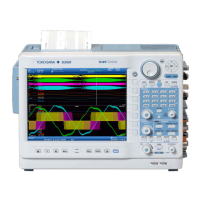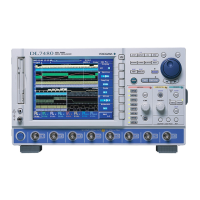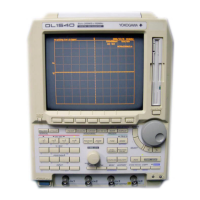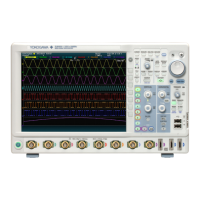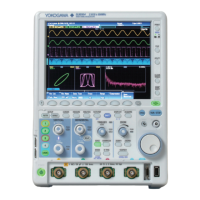2-22
IM DLM6054-01EN
section 8.1 for the procedure
Splitting the Screen
To get a clearer view of analog signals and computed waveforms, you can display waveforms on
split screens. The following split screen settings are available.
Single (no splitting), Dual (split in half),
Triad (split into thirds), and Quad (split into quarters)
Waveform Mapping
You can specify how channels are assigned to split screens.
• Auto
The waveforms whose display is turned on are assigned in order starting with the top screen.
• Manual
You can assign any waveform to any of the split screens regardless of whether the display of the
waveform is turned on or off.
section 8.1 for the procedure
If there is not enough data within 10 divisions of the time axis to fill every point, the DL6000/DLM6000
can use interpolated data to fill in the gaps when it displays waveforms (only pulse interpolation can be
used with logic signals).
Sine Interpolation
The DL6000/DLM6000 interpolates between two data points using the (sinx)/x function. This
method is suitable for the observation of sine waves.
Linear Interpolation
The DL6000/DLM6000 fills in the space between two data points with a straight line.
Pulse Interpolation
The DL6000/DLM6000 interpolates between two points in a staircase pattern.
Interpolation OFF
The DL6000/DLM6000 displays the data using dots without interpolation.
section 8.2 for the procedure
By setting older waveforms to remain on the screen for a period of time that is longer than the
waveform update period, you can continue displaying new waveforms while older ones remain on the
display. The following two modes are available:
• Count
The DL6000/DLM6000 accumulates a set number of waveform
s. Frequency of data occurrence is
indicated through different brightness levels or colors. Frequency of data occurrence is not indicated
for logic signals.
• T
ime
The DL6000/DLM6000 accumulates waveforms for a set period of time. Data recency is indicated
through different brightness levels or colors. Data recency is not indicated for logic signals.
Both of the preceding two modes can be displayed in one of the following two ways:
• Inten
Dif
ferent brightness levels are used.
• Color
Different colors are used.
The accumulated display is useful for observing waveforms with noise and jitter or for observing a
phenomenon with a low frequency of occurrence.
Accumulated waveforms can be saved.
2.6 Display

